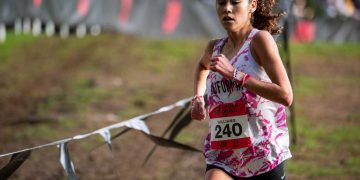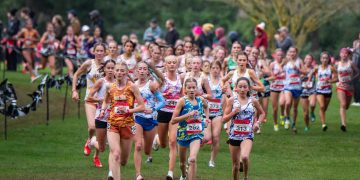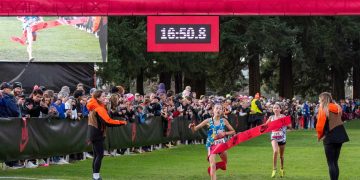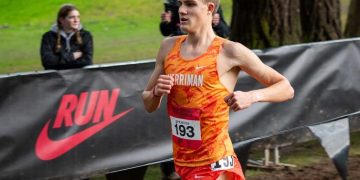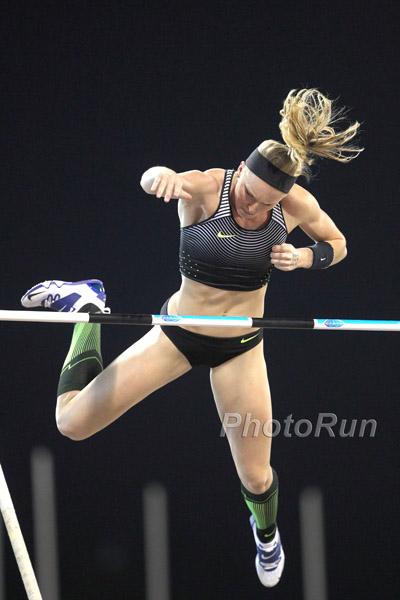 Sandi Morris, photo by PhotoRun.net
Sandi Morris, photo by PhotoRun.net
Reposted June 20, 2017
RelatedPosts
Reposted for January 1, 2018 for Best Moment in June 2017: Sandi Morris continued her amazing 2017 year. This is an example of the amazing performances at the very hot USA Outdoors held in Sacramento, CA.
We liked this piece so much, and @sandicheekspv liked it too, so we decided to repost and encourage more to read about one of our favorite athletes, Sandi Morris!
Sandi Morris is the Olympic silver medalist in the pole vault. She is an amazing athletic talent and a wonderful interview. RunBlogRun interviewed her pre event in Doha, Qatar in early May. David Hunter wrote this feature on Sandi Morris, one our finest athletes and one of our most talented athletes.
We look forward to seeing Sandi Morris continue to improve this year. What new heights will she achieve? That is what David Hunter is suggesting in this article. Enjoy.
When Sandi Morris sailed over 5.00 meters / 16’5″ in last year’s Diamond League pole vault final in Brussels, she became only the third woman in history to conquer that mythical height. It was a clearance that clinched for Morris Track & Field News‘ #1 world pole vault ranking and was the perfect capper for Morris’ 2016 breakout year. It was quite a year indeed for the young South Carolina native who just 4 years earlier was a bundle of unharnessed potential utilizing unrefined technique to clear 4.15 meters / 13’7¼”.
It all started back in Greenville, South Carolina where Sandi grew up in a track & field oriented family. “Both my parents were multi’s at Western Illinois,” explains Morris. “I started track in 2nd grade and I started running hurdles in 6th grade.” In the summer before entering high school, her coach Rusty Shealy, noting Sandi’s speed and jumping agility, worked with her father to teach her the basics of the pole vault. After capturing 2 South Carolina high school state vault championships and a two-year detour through Chapel Hill, Morris ultimately took her talents to Fayettesville where she entered the University of Arkansas with a PR of 4.30m/14’1¼
As a Razorback, Morris blossomed under the watchful eye of Hogs’ jump coach Brian Compton. Compton saw in Morris the vault potential that others had witnessed. But he also found a way to inspire his new athlete to trust his guidance and be willing to change. “My technique in high school was pretty ‘not great’,” Morris confesses. “Once I finally got to Arkansas, Coach Compton told me – and this is my favorite Compton Quote – ‘You can jump about 15 feet your way. Or you could change and jump the world record my way some day.’ So I thought, ‘Wow, this coach believes in me. He thinks I can break the world record if I change.'” After buying in to Compton’s vault approach Morris soared, winning 3 SEC vault crowns, setting an NCAA record of 4.60m/15’1″ in winning the collegiate national indoor title, and capturing a runner-up finish in her final NCAA outdoor championship with a clearance of 4.65m/15’3″.
Continued guidance from Coach Compton and the occasional invaluable tip from her agent – and American indoor vault record holder – Jeff Hartwig have allowed Morris to continue to raise her game not only on the runway but also off the runway. She has become an expert in efficiently addressing all aspects of a highly-technical, carefully-timed, gymnastic-like field event staged in the dizzying swirl that surrounds pole vault competition. “Pole vaulting can definitely be overwhelming because there are a lot of moving pieces. You have to worry about making decisions on where to put your standards, what pole to be on, exactly where your steps need to be And on top of that you’re keeping track of how much time you have, and what your competitors are doing,” explains Morris. “It definitely can be a lot to process and it is like playing a game of chess.” No doubt, a successful world class pole vaulter must be an adroit multi-tasker. “And it took me a long time to learn how to do that,” Morris reveals.
The American outdoor pole vault record holder also has cultivated a deep appreciation for the strategic implications of pole vault competition. Unlike the throws and the horizontal jumps where a magnificent attempt at any time can be the winning performance, vaulters – like high jumpers – know they must be able to deliver that pinnacle jump at the end of the competition when all of the chips are on the table. As such, the world’s best athletes have to analyze and make correct decisions on when to enter the competition, when to pass at certain heights, and when to pass on subsequent attempts when a clearance will not improve event standing – all in an effort to stay in the hunt and conserve energy for what they hope will be that terrific event winning jump at the conclusion of the competition. Because this chess-like strategy can occasionally overwhelm an athlete, some athletes are quick to delegate this analysis to their nearby coaches. “I think it depends on the athlete,” offers Morris candidly when asked which is the preferred approach. “I would say recently I’ve gotten better about handling this myself just because I often go to competition and I might have someone there checking my steps who isn’t usually my coach. I’ve gotten to the point where I have to comprehend and process what is going on in the competition by myself,” explains Morris, pleased with what she has learned. “And I’ve noticed that I tend to do better when I am the one who is playing the chess game in my mind – and I am the one making the decisions. I think when you are in a competition, the athlete needs to be processing what is going on because that keeps you in tune with the competition. I think the athlete needs to be the chess player. Because the athlete is the one who knows how he or she is feeling. The coach can see that the athlete may be clearing bars with plenty of height. But the athlete needs to be confident [about the strategic decisions being made.] Confidence is the key to success. And if the coach wants the athlete to do something and the athlete isn’t hearing it, then it is less likely to happen.”
Like many, Morris has adopted the Brumel-inspired practice of not watching her rivals” vault attempts during competition. “Sometimes I watch more often than other times,” admits Morris who acknowledges that she sometimes sneaks a peek. “In Rio, I was trying not to watch as much. I just focused on my own jumping.” But, clearly, she does keep track of the ever-changing standings as the event progresses. “I do pay attention to whether they [her competitors] were making a bar or not. But I would try not to let my mind think about what my competition was doing. The reason you need to pay attention to it [your competitors’ performances] somewhat is because it comes down to sometimes passing heights. If your competitor makes it on the first attempt and you’re the only two left in the field and you have pretty much solidified 2nd place, then you might as well pass the height. But at the same time, I don’t let myself really focus on it. I try to let my own design on the heights drive me. I would never wish a miss on a competitor. That’s just bad karma.”
Even after her storybook year in 2016 where she registered the world’s two highest clearances, won the USATF indoor and outdoor championships, finished 2nd in the battle for the Diamond League trophy, and on the final jump of the Rio competition was a slight thigh brush away from the gold medal, Morris – a fierce competitor – knows she has room for improvement and is driven to get there. “I have all the speed that is possible. I need to learn how to utilize that speed. What we are always working on is my takeoff and being able to jump off the ground,” offers the former Arkansas star. “I grew up as a sprinter and I had to learn how learn how to run like a vaulter – with a pole in my hands and being able to jump at the end. It’s an ‘almost sprint’, a controlled sprint. My weakness is just setting up the jump to jump at the takeoff. I grew up learning how to jump off of my right leg. But if you are a right handed pole vaulter you have to jump off of your left leg. For years, it always felt so goofy trying to jump off of my left foot. Now I am just starting to get comfortable with it. I can long jump off my left foot and it doesn’t feel weird like it used to. I can hurdle with a left leg lead.” Morris offers a mystical conclusion: “My body is just now wrapping its subconscious mind around jumping off of my left foot.”
Morris understands that the women’s vault is relatively new and that further maturation of the event and its participants will promote continued advancement of vaulters’ performances. “The women’s pole vault hasn’t existed for very long,” explains Morris. “There are more and more young girls jumping at younger ages and getting into it. That’s why we are seeing a wave of girls who are jumping ridiculous heights in high school. Just in the last 5 years we’ve seen several girls jumping 4.60m/15’3 while they are still in college,” states Morris. “I think there are women out there who are capable of jumping 5.10m/16’8¾’. I think I am physically capable of jumping 5.10m, maybe even a little higher. It all comes down to how perfect you can get your technique. My confidence comes from the fact that I know I still have a lot to fix. Can I fix it in the next couple of years? In the next 10 years, the world record could be 5.20m/17’¾”.”
What also will promote continued advancement in the pole vault for Morris is her cordial – yet fierce – rivalry with Katerina Stefanidi. Coe vs. Ovett; Yang vs. Johnson; Thomas vs. Brumel; Simpson vs. Rowbury: our sport is replete with examples of two exemplary athletes in the same event driving each other to even greater performances. Is that how the Olympic silver medalist views her relationship with the Rio champion? “Yeah, but I think the pole vault might be a little bit different because you’re not actually doing anything at the same time as the other person. You compete and you step on the runway and it’s a vault. I like to think of each vault as its own entity. And it doesn’t matter what the competitors bring, in my mind. You just have to focus on your jump and jump as high as you can possibly jump on that day,” offers Morris in outlining a key distinction. “But at the same time, you are competing and they are attempting the same bar as you and it comes down to who jumps the highest bar, obviously. I think that having her [Stefanidi] and other girls as my competitors does make me more competitive and it brings out that competitive animal in all of us. And it does push us to jump even higher,” she explains. “Maybe I jump at 4.70 and that would be a winning jump. You might not normally have the adrenaline to jump at that bar. But if somebody is there and they just made that bar on the same attempt, you’re going to have adrenaline to jump that next bar. It’s funny, because the pole vault is a weird combination. There is individuality – you step out on the runway; it’s your jump; there is nobody going to run out and try and block you like other sports. But it is also competitive – your opponents are attempting the same heights as you. The pole vault is a very interesting balance between those two things.”
Looking back on last year, the Sandi Morris readily admits that continued progression during the outdoor season unfolding is a daunting task indeed. Her outdoor reason is off to a solid start with a vault triumph at Drake with a winning clearance at 4.72m/15’5¾” when inclement weather pulled the event indoors and a 2nd place finish – behind Stefanidi – at Doha with a best vault of 4.75m/15’7″. “It is quite difficult to follow up on a year like 2016,” she admits. Would winning the gold medal at London’s world championship gathering later this summer do the trick? “That would be a nice way to follow it up for sure,” replies the 24-year-old vault queen who quickly adds, “And possibly take some shots at that world record. That would be amazing.”
Always forward thinking, the young vault star is candid about her long term goals. “World championship gold medal, Olympic gold medal, and world record: those are my three goals, the pinnacle of the sport. And I think I am capable of doing that in the next couple of seasons. And even if I was able to accomplish one of those, that would be a blessing right there. And if I could go on and do more than one of those, what more could I ever ask for?”
Author
-

Dave Hunter is an award-winning journalist who is a U.S. Correspondent for Track & Field News. He also writes a weekly column and serves as Senior Writer for www.RunBlogRun.com, and covers championship track & field competition domestically and in such global capitals as Moscow, Birmingham, Zurich, Brussels, Beijing, Rio de Janeiro, Zagreb, Ostrava, and Doha. Hunter frequently serves as the arena or stadium announcer for championship track & field gatherings, including the Ivy League, the Big East, the Mid-American Conference, the NAIA, the Big Ten, and the Millrose Games. Hunter has undertaken foreign and domestic broadcast assignments. He ran his marathon P.R. 2:31:40 on the Boston Marathon course back in the Paleozoic Era. To find out more about Dave, visit his website: www.trackandfieldhunter.com He can be reached at: [email protected]
View all posts




